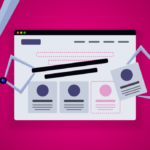In this digital world, we find everything on the internet and a website is often the first place that customers get to know about your company, its products, and services.
We all know that the first impression is the best impression as such the first impression of your website depends on its design.
Customers demand all the information they need about your company on their fingertips. The user engagement depends on the layouts and visuals that are used on the website. Therefore, web development is playing a vital role in the success of your company.
When developing a website every web development project has to go through the certain steps that make their project from initiation to completion.
Below are the five necessary web development steps that can help you understand how a website is designed and developed on a professional scale.
- Project planning
- Project Scope
- Website Designing
- Web Site development
- Website Testing and Development
Project Planning
Project planning refers to deciding the general objectives and targets of the web development project.
This is seemingly the most significant stage in the whole project. It is subdivided into the accompanying five sections such as-
- Prerequisite Assessment
Requirement appraisal alludes to discovering the exact necessities of the site. This incorporates deciding the target audience, website objectives or goals, features, and other similar information about the website.
- Project Summary
The project summary aggregates the website’s requirements. The report is brief and fills in as a kind of perspective point all through the web improvement process.
- Deciding Required Resources
The project planning stage additionally characterizes the product and other asset prerequisites for the website project.
In this progression, any third-party media needs are recognized. The majority of the asset necessities are then added to the financial limit of the venture.
- Key execution objectives/goals
The website arranging stage likewise includes deciding key execution objectives. Project deadlines, budget expenses, and page speed are a part of the website design and improvement objectives that are set at this stage.
- Competitor Analysis
Finally, this stage likewise includes leading competitor analysis investigation.
Which are the adversary organizations of your website? How many visitors will visit the website? What will be their bounce rate? Other significant things that are considered at this stage include visual marking, invitation to take action, navigation, and design.
Determining Project Scope
The next phase of the design process includes deciding the project scope. Making a well-characterized extent of the project will help in guaranteeing that the website project finishes on schedule and within the predefined spending plan.
The ideal approaches to depict the extent of the undertaking are through a Gantt chart or graph. A Gantt graph offers a visual reference for the project.
The outline demonstrates activities involved with the project. It additionally demonstrates the time span for the finishing of each stage.
It helps in determining the extent of the project. In addition, it creates accountability between the web design team.
Website Design
The next crucial phase of the web development process is structuring or designing the website itself.
In this stage, the website development team focuses on choosing the theme, color, format, features, layouts and different aspects of the website.
At this stage, the web designers consolidate different components, for example, organization logo, shading that fortifies brand personality, themes reflecting the organization product portfolio, and format that is rich and looks engaging.
The web designers will make at least one prototype for the website. This is then sent to the website proprietors or owners through email with the mockups of the website.
Website Development
In the website development stage, the website development team takes individual components of the website and uses them to make a utilitarian website.
The stage includes building up a landing page after which a “shell” is made for the inside pages. The shell contains a navigational structure and webpage format without the web content.
When the website owner provides the content, it is appropriated all through the site in the specified areas.
On the technical side, the website development process incorporates components, for example, structuring intuitive contact forms, implementing payment gateways, and choosing a CMS (content administration framework, for example, WordPress, Joomla, and Magneto.
Website Testing and Deployment
The final phase of the website is the testing and deployment process. In this stage, the web designers add final touches to the website and test the website before deployment.
The web designer will test the total usefulness of the site to guarantee that it runs easily with no glitch.
The web designer will test the complete functionality of the website that shows well on various gadgets and stages to check inner connections and other similar tasks.
The website designer will also approve the website codes to ensure that it satisfies the most recent website standards. This ensures the website performs smoothly without any issues and issues.
The website is then sent to its owners to get their last endorsement of the site. After the last endorsement, it is time to deliver the website.
The web design team will upload the website on a hosting server determined and chosen by the website owner utilizing an FTP (File Transfer Protocol) program.
After the website has been uploaded to the hosting server, a final run-through is led to ensure that the site performs without any issues.
This progression is performed just to validate that all files have been uploaded effectively and that the website is completely functional.
At last, the website team adds all the details to the website to enhance its functionality and execution like plugin installation, on-page SEO (Search Engine Optimization), and page speed optimization.
On the last note, you should realize that the web development process takes a lot of time and effort.
Designing a visually engaging website that stands out from its competitors is a tough task. Nevertheless, the stakes are positively more prominent than the effort, cost, and time required to make an excellent engaging website.
















